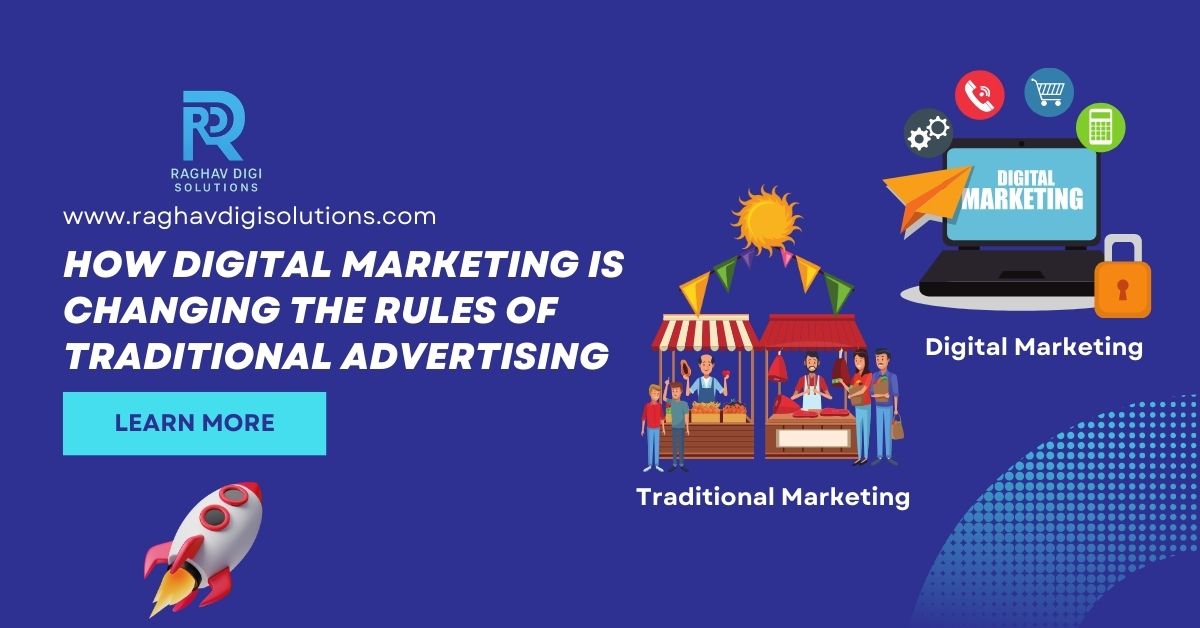Advertising has always been about one thing: getting attention. For decades, businesses relied on television, radio, print, and billboards to reach their audiences.How Digital Marketing is Changing the Rules of traditional advertising methods dominated because they were the only channels available—and they worked well when consumer habits revolved around newspapers and prime-time TV.
But the landscape has changed dramatically. With the rise of the internet, smartphones, and social platforms, digital marketing has not only disrupted traditional advertising—it has rewritten its rules entirely.
In 2025, we are in the middle of a marketing revolution where real-time analytics, hyper-personalization, influencer culture, and AI-driven campaigns are replacing static one-way ads. Businesses no longer ask, “Should we go digital?” Instead, the question is, “How do we blend digital and traditional to maximize ROI?”
This article explores how digital marketing is changing the rules of traditional advertising, highlighting shifts in cost, targeting, engagement, credibility, and consumer behavior.
1. From Mass Messaging to Hyper-Personalization
Traditional Rule: Advertising was a one-size-fits-all message. A TV ad during prime time reached millions, but every viewer saw the exact same message.
Digital Shift: Now, personalization is the new standard. With tools like Google Ads, Meta Business Suite, and AI-driven CRMs, marketers can segment audiences by location, browsing history, income level, or even intent.
- Example: Netflix recommends movies tailored to your watch history.
- Example: Amazon personalizes product ads based on your last search.
Impact: Instead of broadcasting to everyone, digital marketing delivers customized experiences, which increases relevance, conversion rates, and customer loyalty.
2. From High Costs to Scalable Budgets
Traditional Rule: Advertising was expensive. A 30-second prime-time TV spot or a full-page newspaper ad required massive upfront investment, limiting reach to big brands.
Digital Shift: Digital marketing democratized advertising. Anyone can run an Instagram ad campaign for as little as $10, scaling budgets up or down in real time.
- SMEs and startups can compete with larger brands by focusing on niche targeting.
- PPC (pay-per-click) ensures businesses pay only for measurable engagement.
Impact: Marketing has become more accessible, scalable, and performance-driven.
3. From Guesswork to Data-Driven Decisions
Traditional Rule: Measuring success was guesswork. Marketers relied on circulation numbers, TRPs (Television Rating Points), or consumer surveys—often inaccurate and delayed.
Digital Shift: Every click, impression, and conversion can now be tracked in real time. Tools like Google Analytics 4, HubSpot, and SEMrush provide granular insights.
- Businesses can see which ad creatives are performing best.
- A/B testing allows campaigns to be optimized on the go.
Impact: Advertising has shifted from intuition-based decisions to data-driven strategies.
4. From Passive Consumption to Active Engagement
Traditional Rule: Audiences passively consumed ads—whether a radio jingle or a magazine spread. Interaction was minimal.
Digital Shift: Marketing has become interactive and two-way. Consumers can comment, share, review, or message brands instantly.
- Social media builds communities around brands.
- Polls, quizzes, reels, and live sessions encourage user participation.
Impact: Engagement has become the new currency, shifting power from brands to consumers.
5. From Fixed Formats to Multi-Format Creativity
Traditional Rule: Ads had limited formats—TV spots, radio jingles, brochures, or billboards. Creativity was confined to the medium.
Digital Shift: Today’s digital landscape supports limitless creative formats:
- Short-form videos (TikTok, Instagram Reels, YouTube Shorts)
- Long-form content (blogs, podcasts, webinars)
- AR/VR experiences and gamified ads
- Influencer collaborations
Impact: Advertising has transformed into storytelling experiences, adaptable to different platforms and consumer preferences.
6. From Local Reach to Global Presence
Traditional Rule: Most traditional campaigns were geographically limited. A local newspaper or radio ad reached only nearby audiences. Going national meant massive costs.
Digital Shift: With digital channels, businesses can go global instantly.
- A small e-commerce brand in Agra can sell products in the U.S. through Facebook Ads.
- A SaaS startup can market globally using SEO and content marketing.
Impact: Borders no longer exist in advertising, giving even small players a global voice.
7. From Slow Campaigns to Real-Time Flexibility
Traditional Rule: Campaigns required months of planning and execution. Once live, changes were nearly impossible without major costs.
Digital Shift: Digital campaigns can be launched in hours, modified in real time, and optimized continuously.
- Underperforming ads can be paused instantly.
- Budget allocation can shift dynamically across platforms.
Impact: Digital marketing rewards speed, agility, and adaptability.
8. From Brand Control to Consumer Influence
Traditional Rule: Brands controlled the message. Consumers had little voice beyond word-of-mouth.
Digital Shift: Consumers now hold power through reviews, testimonials, and social sharing. One viral tweet or negative review can make or break a campaign.
- Influencers drive brand perception more than traditional celebrity endorsements.
- User-generated content often outperforms brand-made ads.
Impact: Advertising has moved from brand-dictated narratives to consumer-influenced conversations.
9. From Short-Term Impact to Evergreen Value
Traditional Rule: Ads had a limited shelf life. A TV commercial ran during its slot, a newspaper ad disappeared the next day.
Digital Shift: Digital content has evergreen potential.
- Blogs optimized for SEO rank for years.
- YouTube videos continue to generate views long after upload.
- Social media posts can resurface and go viral months later.
Impact: Digital assets create long-term compounding value.
10. From Authority to Authenticity
Traditional Rule: Traditional ads were seen as authoritative. TV and print media were trusted sources, especially by older demographics.
Digital Shift: In the digital era, authenticity trumps authority. Consumers trust peer reviews, influencer recommendations, and behind-the-scenes brand stories more than polished commercials.
- Brands are expected to be transparent and human.
- Storytelling and relatability drive stronger connections than scripted ads.
Impact: Credibility in advertising has shifted from media authority to consumer trust.
The Hybrid Future of Advertising
Digital marketing hasn’t killed traditional advertising—it has reshaped it. Many successful brands in 2025 are integrating both approaches:
- Coca-Cola combines global TV ads with TikTok influencer challenges.
- Nike runs inspirational billboard campaigns while dominating Instagram Reels.
- Luxury brands still rely on glossy print magazines but amplify reach through Instagram collaborations.
The future belongs to hybrid strategies where traditional builds credibility, and digital ensures reach, engagement, and measurability.
To know More: Best Seo Services In Agra, Affordable Digital Marketing Company In Agra




